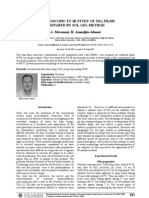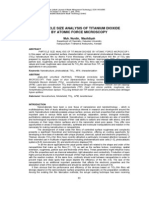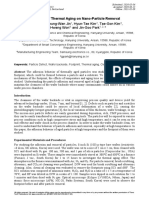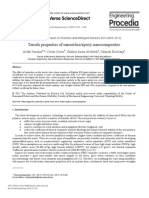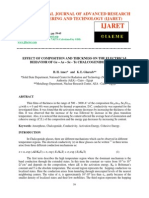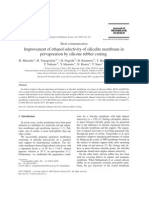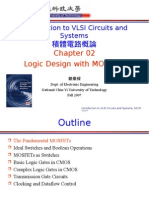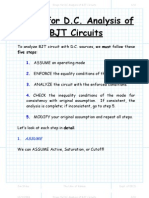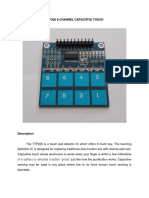Clay Film Technologies
Clay Film Technologies
Uploaded by
khala1391@gmail.comCopyright:
Available Formats
Clay Film Technologies
Clay Film Technologies
Uploaded by
khala1391@gmail.comOriginal Description:
Copyright
Available Formats
Share this document
Did you find this document useful?
Is this content inappropriate?
Copyright:
Available Formats
Clay Film Technologies
Clay Film Technologies
Uploaded by
khala1391@gmail.comCopyright:
Available Formats
Clay Film Technologies
T. Ebina, Dr.
Advanced Functional Materials Team
Research Center for Compact Chemical System
National Institute of Advanced Industrial Science and Technology
(AIST)
Agenda
Concept
Properties
Applications
Acknowledgement
Concept of the clay-based-film
Ideal structure of the self-supported film
Heat durability and gas barrier
performance are expected to improve if
the material is mainly made of clay.
Filler (clay) 8%
Clay-plastic nanocomposite
Gas barrier
performance
improved from twice
to five times.
Lateral dimension up
to a few hundred nm
Thickness
c.a. 1nm
Bentonite paper: E.A. Hauser and D.S. Le Beau, J. Phys. Chem. 42, 961 (1938).
40,000 stacking=40m thick
50,000,000 array=50m long
Outlook
Transparent type
: Made from synthetic clay
Non-transparent type
: Made from natural clay
Claist
Layer structure of clay
2:1 type phyllosilicate
Surface structure of Cs-smectite
c.a. 1nm c.a. 1nm
Tetrahedral sheet
Octahedral sheet
Cation
2:1 type clay
Several hundred nm
montmorillonite
: Na
0.33
[(Al
1.67
Mg
0.33
)Si
4
O
10
(OH)
2
] : Na
0.33
[(Al
1.67
Mg
0.33
)Si
4
O
10
(OH)
2
] : Na
0.33
[(Al
1.67
Mg
0.33
)Si
4
O
10
(OH)
2
] : Na
0.33
[(Al
1.67
Mg
0.33
)Si
4
O
10
(OH)
2
]
Natural clays which form films
XRD chart of a natural bentonite (Volclay)
2
S
M
Q
S
S
Cri
Q
Fel
S
S
S
S
S:smectiteM:micaQ:quartzCri:cristballiteFel:feldsper
XRD chart of a natural bentonite (Volclay)
2
S
M
Q
S
S
Cri
Q
Fel
S
S
S
S
2
S
M
Q
S
S
Cri
Q
Fel
S
S
S
S
S:smectiteM:micaQ:quartzCri:cristballiteFel:feldsper
Bentonite mine in Miyagi, Japan
Mineral
Layer
charge
CEC(meq/100g)
mica 1 1015
Sericite 0.85
Illite 0.75
Vermiculite 0.66 100150
Smectite 0.33 60100
Talc 0
H. Shirouzu, Nendokoubutsugaku Asakura shoten,1988
Various clays and its layer charge
Film formability comparison between natural
and synthetic clay
()
Hectorite (SHCa-1)
Montmorillonite (Kunipia P)
Montmorillonite (Tsukinuno)
Natural
Synthetic
Hectorite (Thixopy) Stevensite (Smecton ST)
Hectorite (Laponite)
Saponite (Smecton SA)
Particle size
ca. 900nm (kunipia P) ca. 40nm (Smecton ST)
2) Enhance gas barrier property
The composite with large particle is expected to be with high gas barrier property.
Effect of enlargement of clay particles
1) Enhance film formability
In general, natural clay show higher film formability than synthetic clay.
Pathway of gas
Polymer
Clay
Pathway of gas
Natural clay
Average aspect ratio (a/b) =320
Synthetic clay
Average aspect ratio (a/b) =50
Experimental
Clay used Synthetic stevensite
(Smecton STKunimine IndustriesNa
0.33
[Mg
2.83
]Si
4
O
10
[OH]
2
)
Hydrothermal treatment Batch-type autoclave (500mL
Suspension of clay (250mL, 0.2wt.%)135400, 10h (temperature
programming rate: target temperature/4h)
Film formability test
Clay dispersion (2 wt.%)
Dry
60, 15h
Self-standing clay film
(30 ~ 50 m)
Polypropylene tray
(17011025 mm)
120
Particle enlargement of clay by a
hydrothermal treatment
(150)
10 um
(300)
10 um
(400)
10 um
(200)
10 um
Hydrothermal treatment is an
effective technique for particle
enlargement !
0 50 100 150 200 250 300 350 400 450
100
1000
10000
P
a
r
t
i
c
l
e
s
i
z
e
/
n
m
Hydrothermal temperature /
o
C
ca. 300 times
Natural clay
Nam, H.-J., Ishii, R., Ebina, T. and Mizukami, F. (2008): Mat. Lett., 63, 54-57.
Original Hydrothermally treated
Improvement of film formability by
hydrothermal treatment
Original 400 200 150
curing
further
processing
Typical preparation procedure of
clay-based-film
Clay: natural, synthetic, organoclay
Additive: plastics, fibers, particles
mixing spreading drying peeling
Surface treatment
Lamination
etc.
Liquid :water(1
st
generation)
toluene(2
nd
generation)
mixed solvent (3
rd
generation)
Clay film preparation
Mechanism of the film formation
Dry
Swelling
Gelation
(Card house structure)
Lamination
Dry Dry
Steps of the film formation
Lamella structure of clay films
TEM section view
SEM section view
XRD pattern of clay film without
organic additive
XRD patterns of clay film type ST with
approximately 10 wt% -caprolactam
10 20 30 40 50 60
2
6.14
1.44 nm
0.311 nm
1.41 nm
0.309 nm
After heated at 250
Before the heat treatment
Various films
A. Heat resistant transparent film(TPP)
B. Water vapor barrier film(SN)
C. Heat resistant insulation film
D. Food packaging(Oxygen barrier)
E. Water vapor barrier coating
0
1
2
3
4
Heat
durability
Transparency
Mechanical
strength
Oxygen
barrier
Water vapor
barrier
A.Heat resistant transparent
film(TPP)
Tomoegawa Co.
Heat resistant transparent film (TPP)
Na+
Na+
Na+ Na+
Na+ Na+
Onium cation
intercalation
Clay
(Hydrophilic )
Organoclay
(Hydrophobic)
K. Kawasaki, T. Ebina et al, Appl. Clay. Sci., 2010, 48, 111-116.
Tetraphenyl phosphonium cation
(TPP)
P
+
Br
-
XRD spectra of TPP-SA film
0 5 10 15 20 25 30
2 theta/deg
I
n
t
e
n
s
i
t
y
/
C
o
u
n
t
s
d
001
1.9nm
Flexible TPP-SA film
Total light transmittance 90%HAZE value 50%
-80
-70
-60
-50
-40
-30
-20
-10
0
0 100 200 300 400 500 600 700
Temperature/
T
G
/
%
D
T
A
/
a
r
b
.
u
n
i
t
e
x
o
e
n
d
o
TG-DTA curve of TPP-SA film
Tomoegawa Co.
200
300
350
400
500
0
10
20
30
40
50
60
70
80
90
200 300 400 500 600 700
Wavelength/nm
T
r
a
n
s
m
i
t
t
a
n
c
e
/
%
200 300 350 400 500
UV-visible light transmittance of TPP-SA films treated at
different temperature
(Heating rate of 5/min.)
TPP-SA films heated up to 350 or 400 exhibited some coloring.
(Their light transmittances of visible light (500nm) were 80% and 79%)
Tomoegawa Co.
0
1
2
3
4
5
Heat durability
Transparency
Mechanical strength Oxygen barrier
Water vapor barrier
B.Water vapor barrier film(SN)
Water vapor barrier film (SN)
2nm
silicate
water
soluble
polymer
2nm
silicate
water
soluble
polymer
Lithium ion
Clay with vacant and positive
charge in the octahedral site
(Montmorillonite, and Stevensite)
1.22nm
silicate
polymer
Heating
>230
Migrate lithium into the
crystal structure
Binder changes to be
waterproof
XRD chart of SN film
0 10 20 30 40 50 60 70
SN20-300d1h
SN5-300d1h
SiLiKunipia100%-300d2h
2thete
0.958
0.475
0.317
0.189
1.230
0.453
0.318
0.188
1.301
0.655
0.441
0.328
0.263 0.219
0.188
No additive
300 2hr
Polyimide 5wt
300 1hr
Polyimide 20wt
300 1hr
2
(nm)
Properties of SN film
Mandrel bending test Thickness15
Water adsorption 0.20% 4090RH
Chemical resistance
Acetone 3.98%
IPA 10.63%
Ethylene glycol 12.20%
Gas barrier property
Oxygen 0.1 cc/m
2
dayatm
Water vapor
0.0012 g/m
2
day
1)
0.027 g/m
2
day
2)
0.0046 g/m
2
day
3)
<0.01 g/m
2
day
4)
85 85%RH
40 90%RH
40 90%RH
40 90%RH
1) API-MS method, 2)Mocon Aquatran3)Technolox Deltaperm 4)GTRtec Gas chromatograph method
0
1
2
3
4
5
Heat durability
Transparency
Mechanical strength Oxygen barrier
Water vapor barrier
C.Heat resistant insulation film
33
Newly developed heat-resistant
film (Toughclaist)
Outlook of Toughclaist A 57cm width TP film
Sumitomoseika Co,. Tokyo University of Science
34
PV module (rear)
(front)
Proposed structure of a solar call using Toughclaist as a backsheet
Glass
PV cell
EVA
Back sheet
Crystal Si solar cell
Insulating layer
Water vapor barrier layer
Structure of typical back sheet
Adhesive agent
Weather durable layer
Proposed back sheet structure
Toughclaist
Sumitomoseika Co,. Tokyo University of Science
Comparison of water vapor
barrier properties of typical films
Sumitomoseika Co,. Tokyo University of Science
Time course change in water vapor permeability of Toughclaist
(Dump heat condition 85, 85%RH,
WVP measurement at 40, 90%RH)
Sumitomoseika Co,. Tokyo University of Science
38
Example of electronic circuits drawn
by a printing method on Toughclaist
(film size 8 cm5 cm)
Draw the pattern by
nanoparticle ink
Heat treatment
200
Screen printing
Cu ink used Ag ink used
Sumitomoseika Co,. Tokyo University of Science
39
Shrinkage by heating
0.04%
0.6%
Comparison of TMA curves between polyimide film and Toughclaist
Sumitomoseika Co,. Tokyo University of Science
0
1
2
3
4
5
Heat durability
Transparency
Mechanical strength Oxygen barrier
Water vapor barrier
D.Food packaging(Oxygen barrier)
Food packaging film
A cross section of the developed oxygen gas barrier film (left),
an enlarged view of the gas barrier layer (middle), and a prototype food
package (right)
Daiwa Can Co.
Self-repair of a scratch
Optical microscope images (height 0.50 mm, width 0.62mm) of
the self-repairing process of the gas barrier layer scratched
(left: just after being scratched, center: after being left for 60
minutes in humid air, right: after drying at 50 degree centigrade
for 36 hrs)
Oxygen gas barrier
3.4 cc/m
2
dayatm 0.98 cc/m
2
dayatm
Daiwa Can Co.
Gelbo flex test
Stretched Maximum distortion
R
e
p
e
t
i
t
i
o
n
Equipment set up
Transparent vacuum deposited film
(after 20 times distortion)
Daiwa Can Co.
Oxygen permeability after gelbo flex
test (cm
3
/m
2
dayatm)
These figures are of laminated film with 25 micrometer thick polypropylene film. The
gelbo flex tests were conducted under 23 degree centigrade and 65 percent related
humidity. he oxygen permeation tests were conducted at room temperature and dry
condition.
cc/m
2
dayatm
Daiwa Can Co.
0
1
2
3
4
5
Heat durability
Transparency
Mechanical strength Oxygen barrier
Water vapor barrier
E.Water vapor barrier coating
Water vapor barrier coating
1. Use synthetic smectite with high aspect ratio
(>2000)
2. Exchange the interlayer cation from Na to
ammonium.
3. Remove excess ion from the
dispersion(<8ppm)
4. Apply the paste on PEN film with the wet
thickness at approximately 0.3 micrometer
5. Heat at 180.
6. Realize high water vapor barrier at 610
-3
g/m
2
day
1)
, and 610
-5
g/m
2
day
2)
1) H. Tanaka, The 5
th
Clayteam Seminar, May.16, 2011, Tokyo
2) Japanese Patent No. 2011-213111
Film properties: Summary
0
1
2
3
4
5
Heat
durability
Transparency
Mechanical
strength
Oxygen
barrier
Water vapor
barrier
A.Heat resistant
transparent film(TPP)
B.Water vapor barrier
film(SN)
C.Heat resistant insulation
film
D.Food packaging(Obygen
barrier)
E.Water vapor barrier
coating
Application map
Heat durability
Gas barrier property
Transparency
Gasket
Hydrogen tank
Food packaging
Barrier film for solar cell
Substrate for solar cell
Substrate for displays
Printable electronics
substrate
Fuel cell seal
Barrier film for OLED
Material design
Self standing or coating heat durability
Natural clay or synthetic claytransparency
Clay loadingflexibility
MultilayerFunction separation
Solid ratio, viscosityproduction process
Properties must, want
Object
Limitation of process
Design
Anti-stick graphite gasket
Advantage
- Non asbestos
- Highly heat-resistant
- Long life
-Good for wide variety of liquids and gases
-Excellent anti-stick surface
EXPANDED GRAPHITE /CLAY GASKETING SHEET
center
Expanded graphite
SUS316 plate 0.11t
Clay coating
Metal cap
Cross section of the gasket
Structure
http://www.japanmatex.co.jp/
Japan Matex Co.
52
Hydrogen Gas Barrier Liners Using Aluminum / Polymer Liners
/ Super Pressure Hydrogen Gas Tank for Automobiles (700 Bars) in
Combination with Filament Winding
Super Pressure Hydrogen Gas Tank
Using Liquid Polymer Liner
(Fuji Heavy Industries. Ltd. )
Issues of Cryogenic Hydrogen Tanks for
Aerospace Application
~ One of the major design concerns is hydrogen
gas permeability
All plastic gas tank is favorable because of
its light-weight.
Current structural concepts of
lightweight hydrogen tank
Kyushu Institute of Technology et al.
Coupons
Thickness
[ mm]
Permeability
[ Pa s m / m mol 10
2 16
]
CFRP (PYLOFIL#380) 1.061 0.529
ST 0.09 0.0009
Claist
HR 0.073 0.0046
ST 1.176 0.0078 Claist Compound
CFRP (PYLOFIL#380) HR 1.174 0.0035
Hydrogen Fuel Hose (Reference 7) - 33.49
Liquid Crystal Polyesters Resin (Reference 8) - 0.625
Virgin IM7/977-2/AF-191 (Reference 9) - 0.4
*Eval Resin (Kuraray Co. Ltd ) 0.031
Hydrogen gas permeability of different coupons
Yonemoto, K., Yamamoto, Y., Ebina, T. and Okuyama, K. (2008):. SAMPE08.
Kyushu Institute of Technology et al.
CFRP Hydrogen tank using clay film as a
gas barrier liner
27L tank
Structure of the clay film/CFRP hydrogen tank
Estimated broken pressure :70MPa
Clay film
CFRP core
CFRP winding
layer
Metal connector
Hand-layupped clay
layer
CFRP filament winding
Yonemoto, K., Yamamoto, Y., Ebina, T. and Okuyama, K. (2008):. SAMPE08.
Kyushu Institute of Technology et al.
Simple firing test
Transparent non-combustive sheet
AIST Press release Successful development of evolutional clay film products , September 13, 2010
Air deflector for vehicles
with flexible solar cell
LED light
Kajiwara Electric Co
O
2
O
2
O2
O
2
O
2
O
2
O2
O2
Claist
Plastic
Glass Fiber
Control with Clay film coating
Proposed applications
New building for transparent material
development; September 2011
Miyagikasei Co.
Fabrication of
flexible OLED
The performance of the OLED is comparable to that
of glass-base device.
Turn on voltage 7.2V
Electroluminescence peak at 530nm
Luminous efficiency 2.7cd A
-1
H. Tetsuka et al., Nanotechnology, 18 355701 (2007).
H. Tetsuka et al., J. Mat. Chem., 17, 3545-3550 (2007).
ITO is treated at 300
410
-4
cm
rf magnetron sputtering
Fabrication of
flexible organic light emitting diodes
Incorporation of hydrophilic nanocrystals into flexible and transparent
clay host using charge-charge interaction between nanocrystal surface
and clay platelet.
Quantum dot photo luminescent device
Tetsuka, H., Ebina, T. and Mizukami, F. (2008): Adv. Mater., 20, 3039-3043.
Preparation of electron (Alq3) and hole transport (NPB) layer:
Photographs of light emission under UV light (365 nm)
.
Preparation of clay
film on glass substrate
Annealed at
60 C for 1h
Polypropylene
substrate
Clay
film
High magnification SEM images of
ZnO thin films on clay substrate.
30 40 50 60 70 80
100
200
300
400
500
P:ZnO/Clay
C-Clay C
(
1
0
1
)
(
0
0
2
)
(
1
0
0
)
X
R
D
I
n
t
e
n
s
i
t
y
(
a
.
u
.
)
2 q (degree)
XRD patterns of ZnO thin film
on clay substrate.
Preparation of ZnO thin film
Towards the development of flexible
optoelectronic devices
Alq3
NPB
Dr. S. Venkatachalm
Clay synthesis from rice husk
Reaction apparatus for excess
heated water vapor reaction
1. Combustion
2. Add Mg and Na
3. Hydrothermal
treatment
Rice husk Synthetic clay
Transparent film made from rice husk
oven
vessel
pump
drain
preheating
line
Hydrogen
Tank
Solar Cell
Material
Natural
clay
Synthetic
clay
Organizing
committee
AIST 4
Company 9
Multipurpose
Sheet
Venture
New
product
No. of Private Company 54
(November 18, 2011)
Established in May 2010.
New
business
Overseas
Clayteam
search
Takeo Ebina, Development of clay-based-film a full research scenario from the viewpoint of encounter, Synthesiology Eng. Ed., 1, 242-2009.
An Industry-Academia-
Government Consortium
Clayteam
Summary
Clay-based flexible film has excellent performance
in thermal stability, gas barrier property, and so on.
Different types of films including transparent types
have been developed to suit different applications.
Development of products using this material on
various applications will contribute to establish the
sustainable society.
Acknowledgements
Authors appreciate their cooperation and supports.
Japan Matex Co. (Gasket maker)
Mr. Katsuro Tsukamoto, Mr. Toshiharu Sakura,
Mr. Yuzo Nakamura
Tomoegawa Co. (Film maker)
Mr. Katsumi Motegi, Mr. Tomohito Inoue
Mr. Hajime Tsuda
Kunimine Industries Co. (Clay supplier)
Mr. Keiichi Kurosaka, Mr. Susumu Shinoki, Mr. Munehiro Kubota
Special thanks to:
MTEC
Dr. Chureerat Prahsarn
TISTR
Ms. Panthenee Somwongsa
Authors also appreciate their cooperation and supports.
Dr Hideyasu Tanaka (Asahi Kasei Co.)
Dr. Takashi Yamashita (Tokyo University of Science)
Mr. Takushi Yamamoto, Mr. Daisuke Mishou, Mr. Seiji Bando, Mr. Noriyuki
Hayashizaka, Mr. Yuuki Umeda (Sumitomo Seika Chemicals Co., Ltd.)
Mr. Jyunji Yamada (Daiwa Can Co.)
Prof. Koichi Yonemoto, Mr. Yuuta Yamamoto, Mr. Koichiro Abe (Kyushu
Institute of Technology )Dr. Keiichi Okuyama (Tsuyama National College of
Technology)Mr. Mutsuya Yamamoto, Mr. Masao Nakano, Mr. Kanji Hanaoka
(Chugoku Kogyo Co.) , Mr. Yoshikuni Yoshimitsu (Kure Sangyo Shinko Center)
Mr. Yasutoshi Kojima (Kouatsu System Co., Ltd)
Mr. Koji Yokota (G.E.S. Co.)
Dr. Hiroshi Yokota, Dr. Kazunori Yamamoto, Dr. Yasuo Kamigata, Dro Hiroyuki
Ishibashi, Dr. Hiroshi Matsuoka (Hitachkasei Chem. Co.)
Authors also appreciate their cooperation and supports.
Mr. Masaru Kajirai (Hitachi Hi-technologies Co.)
Mr. Eishin Iguchi (Techno Eye Inc. )
Mr. Hirotsugu Tsujii (GTR Tech Co.)
Dr. Shiro Yukushima (Sumika Chemical Analysis Service, Ltd.)
Mr. Kensuke Iuchi, Mr. Kazuo Yano (Maruzen Petrochemical Co. Ltd.)
Mr. Masataka Sugawara, Mr. Hiroaki Kobayashi (Maruhachi Co.)
Mr. Akihiko Oyama, Mr. Yuuki Ito, Mr. Masaaki Okada (Miyagikasei Co.)
Mr. Koichiro Kajiwara (Kajiwara Denki Co.)
Mr. Nobuhiko Teshima (South Iwate Research Center of Technology)
Mr. Takahiro Nishiguchi (Nagase ChemteX Co. )
Mr. Yoshimichi Tamura (Toyo Seiki Seisaku-Sho, Ltd.)
Dr. Susumu Minase (Hojyun Co.)
Mr. Jyunichi Yaegashi (Miyagi Sangyo Shinko Kiko)
Thanks to AIST members:
Dr. Takaaki Hanaoka,
Dr. Hiromichi Hayashi, Dr. Yoshito Wakui, Dr. Takashi Nakamura, Dr.
Yasuhisa Hasegawa, Dr. Ryo Ishii, Dr. Tatsuo Tsunoda
Dr. Fujio Mizukami, Dr. Toshihide Kamata , Dr. Manabu Yoshida
Dr. Hiroshi Nanjo, Dr. Nobuko Onozawa, Dr. Kazuhiko Sayama
Dr. S. Venkatachalm
Dr. Hiroyuki Tetsuka, Dr. Hyun-Jeong Nam, Dr. Yasushi Hoshi
Dr. Kazunori Kawasaki, Mr. Shinichi Iwata, Mr. Hideo Sekikawa, Mr. Akira
Togashi, Ms. Eriko Shoji, Ms. Yasuko Nwaneshi, Mr. Mizuki Shimura, Ms.
Fusako Nishikawa, Ms. Mayumi Natsui, Ms. Asami Suzuki
Dr. Tetsuichi Takagi, Dr. Keiichi Ikegami, Dr. Hiroshi Takashima, Dr. Atsushi
Masuda,
Authors thanks to project funds from:
METI, NEDO, JST, JSPS, Miyagi Pref.
You might also like
- Comparison Between LCC and VSCDocument5 pagesComparison Between LCC and VSCijsretNo ratings yet
- Measuring Thermal Crystallinity in PET: Spe Antec Indianapolis 2016Document5 pagesMeasuring Thermal Crystallinity in PET: Spe Antec Indianapolis 2016Silviani SilvyNo ratings yet
- What Is The Definition of The Total, Effective and Required Area and The Difference Between U Clean, U Dirty and U ServiceDocument1 pageWhat Is The Definition of The Total, Effective and Required Area and The Difference Between U Clean, U Dirty and U Servicekhala1391@gmail.comNo ratings yet
- Film ExtrusionDocument44 pagesFilm Extrusionkhala1391@gmail.com100% (1)
- Tektronix 2710 Spectrum Analyzer SM PDFDocument402 pagesTektronix 2710 Spectrum Analyzer SM PDFJpaul RodriguezNo ratings yet
- Preparation of Fluorine-Doped Tin Oxide by A Spray Pyrolysis Deposition and Its Application To The Fabrication of Dye-Sensitized Solar Cell ModuleDocument1 pagePreparation of Fluorine-Doped Tin Oxide by A Spray Pyrolysis Deposition and Its Application To The Fabrication of Dye-Sensitized Solar Cell ModuleFahad ArefeenNo ratings yet
- 5ungureanu PDFDocument5 pages5ungureanu PDFsuganyaNo ratings yet
- Preparation and Characterization of TiO2 Nanotube Arrays Via Anodization of Titanium Films Deposited On FTO Conducting Glass at Room TemperatureDocument7 pagesPreparation and Characterization of TiO2 Nanotube Arrays Via Anodization of Titanium Films Deposited On FTO Conducting Glass at Room TemperatureAruna RajanNo ratings yet
- 1 s2.0 S1876610211017644 MainDocument9 pages1 s2.0 S1876610211017644 Mainayabulela421No ratings yet
- Spectroscopic Ft-Ir Study of Tio Films Prepared by Sol-Gel MethodDocument4 pagesSpectroscopic Ft-Ir Study of Tio Films Prepared by Sol-Gel Methodpneumann123No ratings yet
- Preparation of Resin/nano Fillers Mixture For Composites: A Case StudyDocument11 pagesPreparation of Resin/nano Fillers Mixture For Composites: A Case StudyNiranjan HugarNo ratings yet
- Alem, Sarpoolaky, Keshmiri - 2009 - Sol-Gel Preparation of Titania Multilayer Membrane For Photocatalytic ApplicationsDocument7 pagesAlem, Sarpoolaky, Keshmiri - 2009 - Sol-Gel Preparation of Titania Multilayer Membrane For Photocatalytic ApplicationsBFCNo ratings yet
- Abs. 670, 204th Meeting, © 2003 The Electrochemical Society, IncDocument1 pageAbs. 670, 204th Meeting, © 2003 The Electrochemical Society, IncsvngreddyNo ratings yet
- Particle Size Analysis of Titanium Dioxide by Atomic Force MicrosDocument9 pagesParticle Size Analysis of Titanium Dioxide by Atomic Force MicrosAdi Adams AndaroffsaNo ratings yet
- Yeoho Kim, Seung-Wan Jin, Hyun-Tae Kim, Tae-Gon Kim, Kyu-Hwang Won and Jin-Goo ParkDocument6 pagesYeoho Kim, Seung-Wan Jin, Hyun-Tae Kim, Tae-Gon Kim, Kyu-Hwang Won and Jin-Goo Parksumit kumarNo ratings yet
- Tensile Properties of Nanosilica/epoxy NanocompositesDocument7 pagesTensile Properties of Nanosilica/epoxy Nanocompositesgaurav503050No ratings yet
- Photocatalytic Tio Thin Film Deposited Onto Glass by DC Magnetron SputteringDocument7 pagesPhotocatalytic Tio Thin Film Deposited Onto Glass by DC Magnetron SputteringMario PgNo ratings yet
- TiO2 Art1Document7 pagesTiO2 Art1taoufik garmimNo ratings yet
- Cib DC24777 2Document9 pagesCib DC24777 2The crypto GuyNo ratings yet
- Tsai 2003Document7 pagesTsai 2003Guilherme Alves MartinezNo ratings yet
- Surface Structure and Composition of Flat Titanium Thin Films As A Function of Film Thickness and Evaporation RateDocument16 pagesSurface Structure and Composition of Flat Titanium Thin Films As A Function of Film Thickness and Evaporation Ratenandza99No ratings yet
- Preparation of Resin/nano Fillers Mixture For CompositeDocument27 pagesPreparation of Resin/nano Fillers Mixture For CompositeNiranjan HugarNo ratings yet
- Chankrachang 2018 IOP Conf. Ser. Mater. Sci. Eng. 297 012061Document10 pagesChankrachang 2018 IOP Conf. Ser. Mater. Sci. Eng. 297 012061AzifahNo ratings yet
- A Study of Adhesion of Silicon Dioxide On Polymeric Substrates For Optoelectronic ApplicationsDocument19 pagesA Study of Adhesion of Silicon Dioxide On Polymeric Substrates For Optoelectronic ApplicationsAnnamalai SathiyaveluNo ratings yet
- J Mat Sci 2011, 46, 6508 Efecto de La Organoarcilla Con Diferentes Modificadores Organicos en Las Propiedades TermoplasticasDocument10 pagesJ Mat Sci 2011, 46, 6508 Efecto de La Organoarcilla Con Diferentes Modificadores Organicos en Las Propiedades TermoplasticasDavid ContrerasNo ratings yet
- Self-Cleaning Cotton FabricsDocument6 pagesSelf-Cleaning Cotton FabricsAliAkbarPamungkasNo ratings yet
- FTO ITO Double-Layered Transparent Conductive Oxide ForDocument4 pagesFTO ITO Double-Layered Transparent Conductive Oxide Forjose manuel acosta saavedraNo ratings yet
- National Center For Radiation Recearch and Technology, P.O. Box 29, Nasr City, Cairo, EgyptDocument15 pagesNational Center For Radiation Recearch and Technology, P.O. Box 29, Nasr City, Cairo, EgyptFREDY CORREANo ratings yet
- The Change of The Properties of Acrylic-Based Polyurethane Via Addition of Nano-SilicaDocument10 pagesThe Change of The Properties of Acrylic-Based Polyurethane Via Addition of Nano-SilicasggdgdNo ratings yet
- Flexible Nanocrystal-Coated Glass Fibers For High-Performance Thermoelectric Energy HarvestingDocument6 pagesFlexible Nanocrystal-Coated Glass Fibers For High-Performance Thermoelectric Energy HarvestingMunna EceNo ratings yet
- Rapid Evaluation of Photo, Thermal, and Oxidative Degradation of EPDM by Online UV Irradiation PY-GC/MSDocument4 pagesRapid Evaluation of Photo, Thermal, and Oxidative Degradation of EPDM by Online UV Irradiation PY-GC/MSRita RosadoNo ratings yet
- Adobe Scan 03 Mar 2024 (5)Document8 pagesAdobe Scan 03 Mar 2024 (5)rawan naserNo ratings yet
- Dry Self-Lubricating Composites: Shin Jen Shiao and Te Zei WangDocument7 pagesDry Self-Lubricating Composites: Shin Jen Shiao and Te Zei WangAhda Dapong Rizqy MaulanaNo ratings yet
- Yankov 2018 IOP Conf. Ser. Mater. Sci. Eng. 416 012062Document9 pagesYankov 2018 IOP Conf. Ser. Mater. Sci. Eng. 416 012062metalabNo ratings yet
- 2017 Tubular Ultrafiltration Ceramic Membrane Based On Titania NanoparticlesDocument8 pages2017 Tubular Ultrafiltration Ceramic Membrane Based On Titania NanoparticlesMuhammad Arqam ZaheerNo ratings yet
- 1 s2.0 S0032591007001799 MainDocument8 pages1 s2.0 S0032591007001799 MainTomas ZadravecNo ratings yet
- The Design and Performance Research of PTFE - PVDF - PDMS Superhydrophobic Radiative Cooling CompositeDocument11 pagesThe Design and Performance Research of PTFE - PVDF - PDMS Superhydrophobic Radiative Cooling CompositeFF TamizhaNo ratings yet
- JP 48 91 118Document4 pagesJP 48 91 118jamel-shamsNo ratings yet
- 15.E2. Jurnal Stoichiometry Composition of Nanofiller SiO2 and ATH 2022Document9 pages15.E2. Jurnal Stoichiometry Composition of Nanofiller SiO2 and ATH 2022mustaminNo ratings yet
- EPL 0002593 ArticleDocument7 pagesEPL 0002593 Articlesus023No ratings yet
- Sarvari 2017Document5 pagesSarvari 2017Ebubekir CamızcıNo ratings yet
- Composites: Part A: Cheng-Ho Chen, Jian-Yuan Jian, Fu-Su YenDocument6 pagesComposites: Part A: Cheng-Ho Chen, Jian-Yuan Jian, Fu-Su Yensur22as.aswarNo ratings yet
- Effect of SilaneDocument20 pagesEffect of SilaneVansala GanesanNo ratings yet
- Ijaret: International Journal of Advanced Research in Engineering and Technology (Ijaret)Document7 pagesIjaret: International Journal of Advanced Research in Engineering and Technology (Ijaret)IAEME PublicationNo ratings yet
- Thepthong 2020 IOP Conf. Ser.- Mater. Sci. Eng. 773 012057Document5 pagesThepthong 2020 IOP Conf. Ser.- Mater. Sci. Eng. 773 012057Nutty MemesNo ratings yet
- s10854 017 6943 1Document9 pagess10854 017 6943 1karthik tvkNo ratings yet
- 2023 PreheatingDocument10 pages2023 Preheating이상민No ratings yet
- Fabrication of High-K Dielectric Calcium Copper Titanate (CCTO) Target by Solid State RouteDocument5 pagesFabrication of High-K Dielectric Calcium Copper Titanate (CCTO) Target by Solid State RouteArindam SenNo ratings yet
- I-V Characteristic of Cdo/Ps HeterojunctionDocument6 pagesI-V Characteristic of Cdo/Ps HeterojunctionInternational Journal of Application or Innovation in Engineering & ManagementNo ratings yet
- Low Temperature Synthesis of Cdo NC by Solvothermal Methods Without Using Any AdditivesDocument4 pagesLow Temperature Synthesis of Cdo NC by Solvothermal Methods Without Using Any Additivesprakush_prakushNo ratings yet
- UV Absorption by Cerium Oxide Nanoparticles/epoxy Composite Thin FilmsDocument5 pagesUV Absorption by Cerium Oxide Nanoparticles/epoxy Composite Thin FilmshuutrinhNo ratings yet
- Degradation of Different Gasket MaterialsDocument7 pagesDegradation of Different Gasket MaterialsAravind ShankarNo ratings yet
- Aqueous Solution-Gel Preparation of Ultrathin Zro Films For Gate Dielectric ApplicationDocument23 pagesAqueous Solution-Gel Preparation of Ultrathin Zro Films For Gate Dielectric Applicationvick ENo ratings yet
- Polymer Nanocomposites For Inflatable Space Structure ApplicationsDocument44 pagesPolymer Nanocomposites For Inflatable Space Structure ApplicationsRajyalakshmi GollakotaNo ratings yet
- Uv Curable Hard Coatings On PlasticsDocument4 pagesUv Curable Hard Coatings On PlasticsinzanerNo ratings yet
- 2019 Sep 30 Development of Nano PhotocatalyticDocument7 pages2019 Sep 30 Development of Nano PhotocatalyticPheeraphong BunroekNo ratings yet
- Effect of Nitrogen Flow Rate On Structure and Properties of Nanocrystalline Tin Thin Films Produced by Unbalanced Magnetron SputteringDocument8 pagesEffect of Nitrogen Flow Rate On Structure and Properties of Nanocrystalline Tin Thin Films Produced by Unbalanced Magnetron SputteringEngels OchoaNo ratings yet
- Manufacture and Characterization of CuO Semiconductive P Type Transparent Thin Films by DC Sputtering v0Document22 pagesManufacture and Characterization of CuO Semiconductive P Type Transparent Thin Films by DC Sputtering v0Pilar Gnade del ValleNo ratings yet
- 1 - Buta 6pagDocument6 pages1 - Buta 6pagAhmad Junaid BandeshaNo ratings yet
- Effect of Temperature in The Tubular Ceramic Membrane Sintering Obtained With Kaolin and Ball ClayDocument8 pagesEffect of Temperature in The Tubular Ceramic Membrane Sintering Obtained With Kaolin and Ball ClayBenilton OliveiraNo ratings yet
- Effect of Carbon Nanotubes On Friction and Wear Properties of Glass Fiber/Epoxy CompositesDocument7 pagesEffect of Carbon Nanotubes On Friction and Wear Properties of Glass Fiber/Epoxy CompositesAndresNo ratings yet
- Improvement of Ethanol Selectivity of Silicalite Membrane in Pervaporation by Silicone Rubber CoatingDocument5 pagesImprovement of Ethanol Selectivity of Silicalite Membrane in Pervaporation by Silicone Rubber CoatingCristina TabletNo ratings yet
- Photocatalytic Membrane of A Novel High Surface Area Tio Synthesized From Titanium Triisopropanolamine PrecursorDocument6 pagesPhotocatalytic Membrane of A Novel High Surface Area Tio Synthesized From Titanium Triisopropanolamine PrecursorNanuNo ratings yet
- Ceramics for Environmental SystemsFrom EverandCeramics for Environmental SystemsLianzhou WangNo ratings yet
- Electronic Grade 2013 BDDocument2 pagesElectronic Grade 2013 BDkhala1391@gmail.comNo ratings yet
- ข่าว1 pdf-notes flattened 201307151439Document4 pagesข่าว1 pdf-notes flattened 201307151439khala1391@gmail.comNo ratings yet
- Principles of Electric Circuits - FloydDocument40 pagesPrinciples of Electric Circuits - FloydhdjskhdkjsNo ratings yet
- XM 554ZRDocument22 pagesXM 554ZRJosé Miguel Barbosa Hernández67% (3)
- Hatem Diab ThesisDocument83 pagesHatem Diab ThesisLaquesta AinshtaeinNo ratings yet
- Single Phase Power Factor Correction Circuit With Wide Output Voltage RangeDocument110 pagesSingle Phase Power Factor Correction Circuit With Wide Output Voltage RangeBritto TigerNo ratings yet
- Unidirectional ThyristorDocument5 pagesUnidirectional ThyristorArvin Dexter De CastroNo ratings yet
- Does Gan Have A Body Diode? - Understanding The Third Quadrant Operation of GanDocument7 pagesDoes Gan Have A Body Diode? - Understanding The Third Quadrant Operation of Gannataphon kabkaewNo ratings yet
- RF OscillatorsDocument11 pagesRF OscillatorsMohammad Irani0% (1)
- Cascode Connection AmplifierDocument11 pagesCascode Connection Amplifiers2021677No ratings yet
- HP Compaq Notebook Pricelist: NET Screen Size Color Graphics Card Wireles S/bluto Model No Processor RAM HDD OSDocument18 pagesHP Compaq Notebook Pricelist: NET Screen Size Color Graphics Card Wireles S/bluto Model No Processor RAM HDD OSsarwan_v3No ratings yet
- Characteristics of Arc Plasma Deposited TiAlZrCN CoatingsDocument7 pagesCharacteristics of Arc Plasma Deposited TiAlZrCN CoatingsПавел МисуноNo ratings yet
- Iot PPT 1Document16 pagesIot PPT 1SajalNo ratings yet
- Unit 1Document15 pagesUnit 1TPO ECE YCOENo ratings yet
- Final Exam: Question 1 (L.O.2) (2.0pts.) : Node-Voltage MethodDocument4 pagesFinal Exam: Question 1 (L.O.2) (2.0pts.) : Node-Voltage MethodPham Lê HuyNo ratings yet
- MSE630 HW3 Solutions F08Document4 pagesMSE630 HW3 Solutions F08Tri NguyenNo ratings yet
- DM74LS153 Dual 1-Of-4 Line Data Selectors - MultiplexersDocument2 pagesDM74LS153 Dual 1-Of-4 Line Data Selectors - Multiplexersps4 freeNo ratings yet
- Chapter02 - Logic Design With MOSFETsDocument51 pagesChapter02 - Logic Design With MOSFETsbal3xNo ratings yet
- Datasheet 4Document28 pagesDatasheet 4Kholit LitNo ratings yet
- CSC7132 PWM Ac/Dc CSC7132 / / CSC7132 EMI EMI CSC7132 VDD PWM/PFMDocument4 pagesCSC7132 PWM Ac/Dc CSC7132 / / CSC7132 EMI EMI CSC7132 VDD PWM/PFMNiltonNo ratings yet
- TransducerDocument70 pagesTransducersmcoolguy68100% (1)
- Orginal ProjectDocument18 pagesOrginal ProjectSaravana KumarNo ratings yet
- Tutorial Chapter 5Document6 pagesTutorial Chapter 5SYAFIQAH ISMAILNo ratings yet
- Typical Questions and AnswersDocument158 pagesTypical Questions and Answersiragire viateurNo ratings yet
- Steps For DC Analysis of BJT CircuitsDocument11 pagesSteps For DC Analysis of BJT CircuitsFarizal KamarzamanNo ratings yet
- Ttp226 8way Touch SensorDocument8 pagesTtp226 8way Touch SensorCarlos BlondelNo ratings yet
- 1N3208 Thru 1N3211R: Silicon Standard Recovery DiodeDocument4 pages1N3208 Thru 1N3211R: Silicon Standard Recovery Diodefernando heNo ratings yet
- KlystronDocument6 pagesKlystronPAVITHRAN SRIDHARNo ratings yet
- Active Low Pass FilterDocument12 pagesActive Low Pass FilterSayani Ghosh100% (1)
- Midterm Exam Model 1 - Answer ModelDocument3 pagesMidterm Exam Model 1 - Answer ModelMaher Gomaa IsmaeelNo ratings yet









